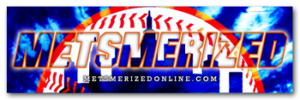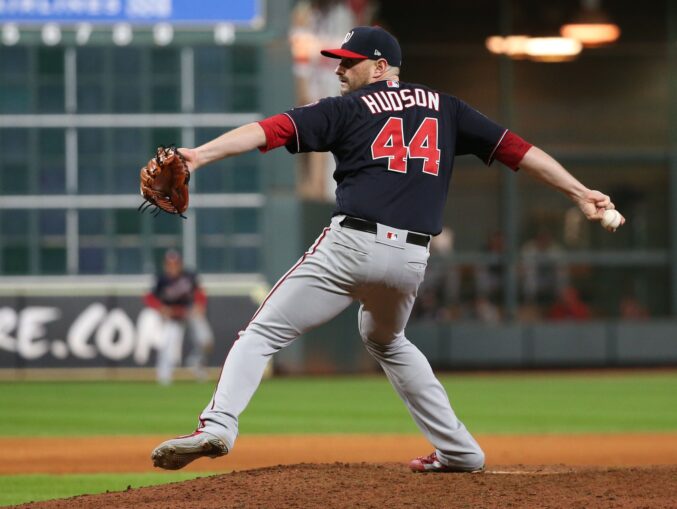
Credit: Brad Mills-USA TODAY Sports
With this year’s trade deadline on the horizon, there’s no question the New York Mets will be working around the clock while they attempt to upgrade their roster.
Though the front office has already made an addition to the starting rotation and is focused on acquiring another reliable hitter, this team could also benefit from improving the bullpen before the deadline passes on Friday. It could allow them to feature an elite group of relievers down the stretch and into the postseason.
As currently constructed, the Mets’ bullpen possesses a handful of quality high-leverage arms, including Edwin Diaz, Trevor May, Jeurys Familia, Seth Lugo, and Aaron Loup. While this group has performed extremely well up to this point, it’d be wise for management to solidify the backend of the pitching staff by trading for a shutdown hurler who’s capable of occasionally closing games if needed.
General manager Zack Scott recently admitted he feels comfortable dealing inside the National League East. The Washington Nationals could become an ideal trading partner, especially since they feature a couple of interesting trade chips. In addition to ace Max Scherzer reportedly being available, they’re also open to moving their top two relievers in Daniel Hudson and Brad Hand. The Mets were previously interested in Hand last off-season.
Hand hasn’t performed up to his high expectations this season. He’s posted a troubling 3.67 ERA, 4.66 xERA, 4.40 FIP, 4.68 xFIP, a 0.1 fWAR rating, and five blown saves through 41.1 innings. It probably wouldn’t be beneficial to acquire his services. As for his teammate, Hudson, pursuing him would be a smarter decision as he’s enjoying one of the top statistical performances of his career.
Overcoming his woes from last season, where he produced a 6.10 ERA, 4.30 xERA, 6.29 FIP, 5.13 xFIP, and a career-worst -0.4 fWAR rating over 20.2 innings, the right-hander has led the way for the Nationals’ bullpen in 2021, allowing him to sit tied for the 11th-highest fWAR rating (1.0) among all qualified relievers, according to FanGraphs.com.
Hudson’s compiled 32.2 innings so far this season, for a career-best 2.20 ERA, 2.49 xERA, 2.45 FIP, 2.88 xFIP, .192 OPP AVG, 37.8% strikeout rate, 5.5% walk rate and 14 holds (most since 2017).
One of the biggest concerns about the 6’3″ hurler’s performance last season was in his inability to limit walks, as he recorded the second-worst walk rate (12.0%) of his entire career. After some crucial adjustments over the winter, he’s been more consistent with his command and owns the 16th-lowest walk rate among all relievers in the majors.
Reaping the benefits of his improved accuracy, Hudson has been able to generate significantly more swings and misses compared to his inaugural campaign in Washington. His strikeout rate has increased by 7.4% since 2020. Additionally, the veteran pitcher’s whiff rate received a notable boost this season, seeing it climb from 31.1% in 2020 up to a career-best 34.5% in 2021.
In the final season of his two-year, $11 million contract, there’s a good chance the 34-year-old will be moved sometime before Friday’s deadline passes.
Putting aside what it could cost to acquire him, his ability to keep runners off base and induce high amounts of strikeouts makes him a clear target for the Mets, as adding the impending free agent to the mix would help their bullpen continue to thrive in high-leverage situations.
Exploring Hudson’s arsenal, the former fifth-round selection primarily relies on his high-90s fastball, which has averaged 97.1 mph and has been utilized 72.7% this season. Unlike last season, his electric heater has been a much more competitive offering so far, preventing opposing batters from giving up on it when it’s been located on the edge of the strike zone.
As a result, his fastball hasn’t experienced any issues inducing consistent amounts of swings and misses, which has been a problem in the past. Breaking through those previous woes, his four-seamer has registered new career-highs involving its strikeout rate (32.6%), whiff rate (29.0%), and chase whiff rate (51.1%).
Similar to his fastball, Hudson made positive strides with his high-80s slider and has increased its usage up to 24.2% this season – its highest usage since the 2018 campaign, where it was thrown 41.0% of the time.
Even though his breaking ball still allows a fair amount of hard contact (45.5% in 2021), the hard-throwing righty has countered that issue by improving its effectiveness at creating swings and misses, particularly within the strike zone.
In 2020, Hudson’s slider produced a 35.0% strikeout rate, a 48.1% whiff rate, and a 29.4% in-zone whiff rate through 20 plate appearances against it. As for this season, it has seemingly transformed into an elite strikeout weapon, as it’s posted a 57.1% strikeout rate, a 54.2% whiff rate, and a 42.5% in-zone whiff rate through 28 plate appearances against it.
Comparing these stellar results to the rest of the majors, Hudson has recorded the sixth-highest strikeout rate and the eighth-highest whiff rate among all pitchers who’ve totaled at least 25 plate appearances against their slider, according to BaseballSavant.com.
While trading with a division rival could prove to be difficult, especially if the Nationals decide to play hardball during negotiations, landing Hudson still might not be as expensive as some experts may think. Since he’s considered a rental, the Mets probably wouldn’t need to surrender any of their top 10 prospects in exchange for him.
Based on Washington’s top 30 prospect list, according to MLB.com, it appears they’re attempting to stockpile young pitchers and New York could certainly help them continue that process by submitting an offer that’s centered around prospect Jose Butto, who’s ranked as the team’s No. 15 prospect.
Along with Butto, the Mets could include outfielder Jake Mangum, who’s ranked as the N0. 30 prospect in their system. Considering the Nationals only feature two outfielders on their top 30 prospect list and both are positioned in rookie ball, this potential offer would likely address two areas of need for their organization.
On the surface, swapping two young prospects in exchange for a veteran reliever who could depart after the season would be risky, however, these past few seasons have taught everyone that having too many high-leverage arms is never a bad outcome.
For the Mets in particular, bringing Hudson into the fold that already includes pitchers like Diaz, May, Familia, Lugo, and Loup would likely take some pressure off their injury-riddled starting rotation. Taking this even further, making this move could allow the bullpen to shorten games in the playoffs, which has proven to be a very effective strategy in the past.
With this team aiming to make its first postseason appearance since 2016, it’d be wise for them to take full advantage of this current opportunity that’s in front of them and improve their roster as much as possible ahead of this final stretch of the schedule.
















